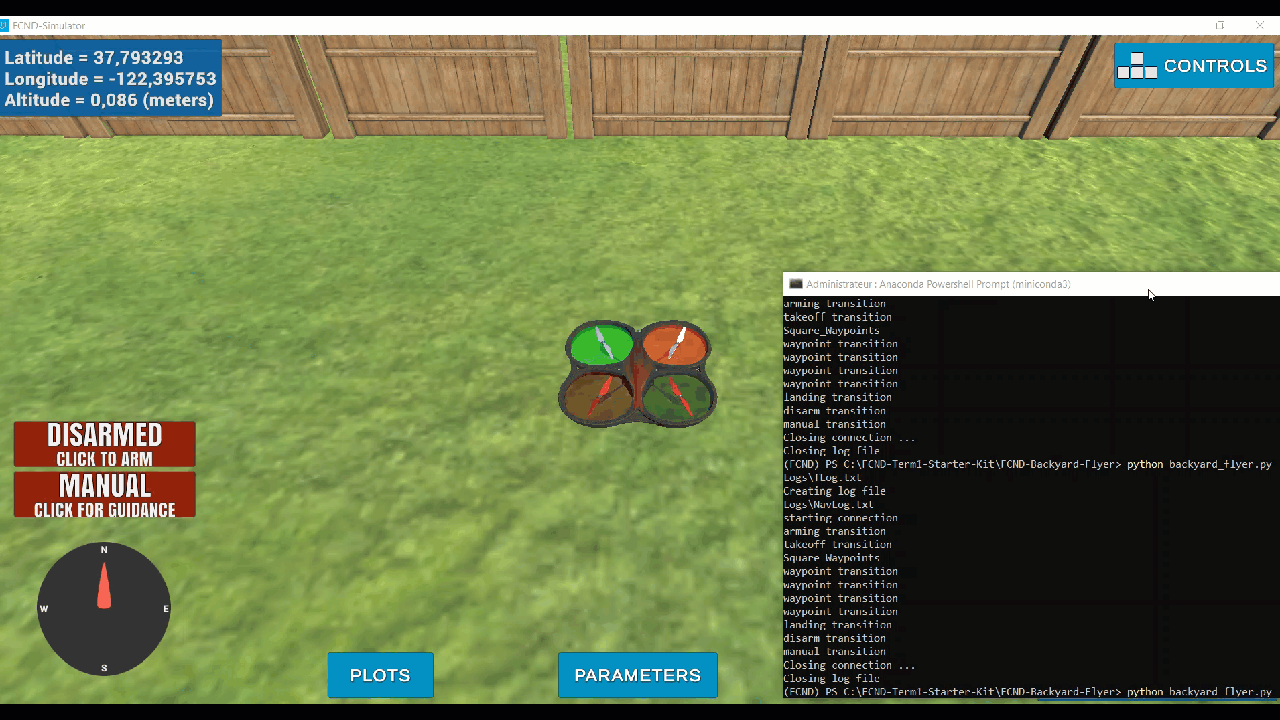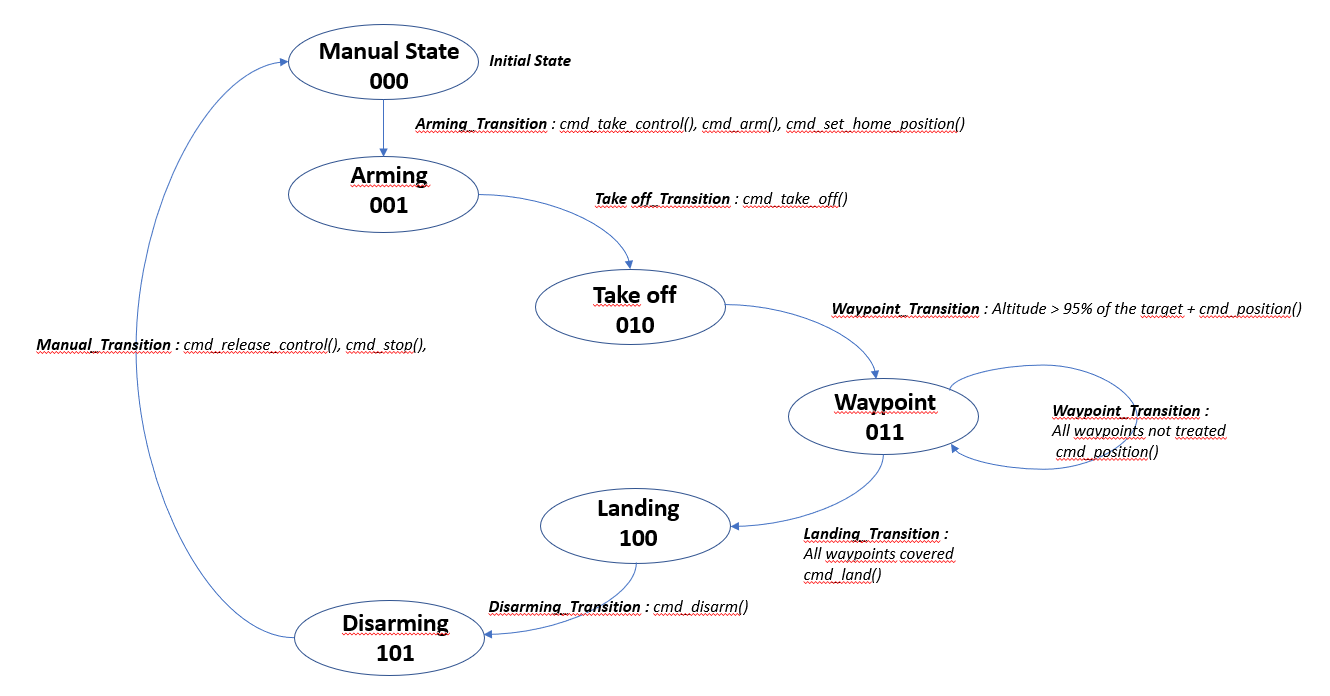Results visualization with the simulator here.
The target of this project is to design a finite state machine using event-driven programming for autonomously flying a drone.
The written python code is similar to how the drone would be controlled from a ground station computer or an onboard flight computer.
The communication with the drone is done using MAVLink.
The required task is to command the drone to fly a 10 meter box at a 5 meter altitude.
Two ways to fly : first using manual control and then under autonomous control.
Manual control of the drone is done using the instructions found with the simulator.
Autonomous control will be done using an event-driven state machine. Each callback function checks against transition criteria dependent on the current state. If the transition criteria are met, it will transition to the next state and pass along any required commands to the drone.
The UdaciDrone API's Drone class delivers a list of command. They are described in this repository;
The "Mealy machine" (asynchronous graph) described the SW architecture :
While the drone is in each state, the state machine will need to check transition criteria with a registered callback. If the transition criteria are met, the state machine will set the next state and pass along any commands to the drone. For example:
def state_callback(self):
if self.state == States.DISARMING:
if !self.armed:
self.release_control()
self.in_mission = False
self.state = States.MANUALThis is a callback on the state message. It only checks anything if it's in the DISARMING state. If it detects that the drone is successfully disarmed, it sets the mode back to manual and terminates the mission.
The Drone class contains the following attributes that you may find useful for this project:
self.armed: boolean for the drone's armed stateself.guided: boolean for the drone's guided state (if the script has control or not)self.local_position: a vector of the current position in NED coordinatesself.local_velocity: a vector of the current velocity in NED coordinates
The UdaciDrone API's Drone class also contains function to be able to send commands to the drone.
connect(): Starts receiving messages from the drone. Blocks the code until the first message is receivedstart(): Start receiving messages from the drone. If the connection is not threaded, this will block the code.arm(): Arms the motors of the quad, the rotors will spin slowly. The drone cannot takeoff until armed firstdisarm(): Disarms the motors of the quad. The quadcopter cannot be disarmed in the airtake_control(): Set the command mode of the quad to guidedrelease_control(): Set the command mode of the quad to manualcmd_position(north, east, down, heading): Command the drone to travel to the local position (north, east, down). Also commands the quad to maintain a specified headingtakeoff(target_altitude): Takeoff from the current location to the specified global altitudeland(): Land in the current positionstop(): Terminate the connection with the drone and close the telemetry log
The state machine is run continuously until either the mission is ended or the Mavlink connection is lost.
The six states predefined for the state machine:
MANUAL: the drone is being controlled by the userARMING: the drone is in guided mode and being armedTAKEOFF: the drone is taking off from the groundWAYPOINT: the drone is flying to a specified target positionLANDING: the drone is landing on the groundDISARMING: the drone is disarming
Download the version of the simulator that's appropriate for your operating system from this repository. Download Miniconda with Python 3.6 [from this repository] (https://conda.io/miniconda.html)
Set up your Python environment and get all the relevant packages installed using Anaconda following instructions in this repository
git clone https://github.com/udacity/FCND-Backyard-FlyerUpdate the latest conda version with this command in the "miniconda prompt window" :
conda update -n base condaConda environment for the project creation with this command in the "miniconda prompt window" :
conda env create -f environment.yml
FCND environment activation with this command in the "miniconda prompt window" :
conda activate FCND or source activate FCNDRun the code in the "miniconda prompt" window with the command :
python backyard_flyer.pyRun the drone simulator : the drone makes the sqaure with the 4 waypoints. Information : The drones moves slowly beacuse the deadband radius is initialized with 0,1 meters in the code. The precision to reach a waypoint is prefered to the speed realization. In others case, with a deadband radius = 10 meters, the speed realisation will be prefered as the precision.
The telemetry data is automatically logged in "Logs\TLog.txt" or "Logs\TLog-manual.txt" for logs created when running python drone.py. Each row contains a comma seperated representation of each message. The first row is the incoming message type. The second row is the time. The rest of the rows contains all the message properties. The types of messages relevant to this project are:
MsgID.STATE: time (ms), armed (bool), guided (bool)MsgID.GLOBAL_POSITION: time (ms), longitude (deg), latitude (deg), altitude (meter)MsgID.GLOBAL_HOME: time (ms), longitude (deg), latitude (deg), altitude (meter)MsgID.LOCAL_POSITION: time (ms), north (meter), east (meter), down (meter)MsgID.LOCAL_VELOCITY: time (ms), north (meter), east (meter), down (meter)
Logs can be read using:
t_log = Drone.read_telemetry_data(filename)
